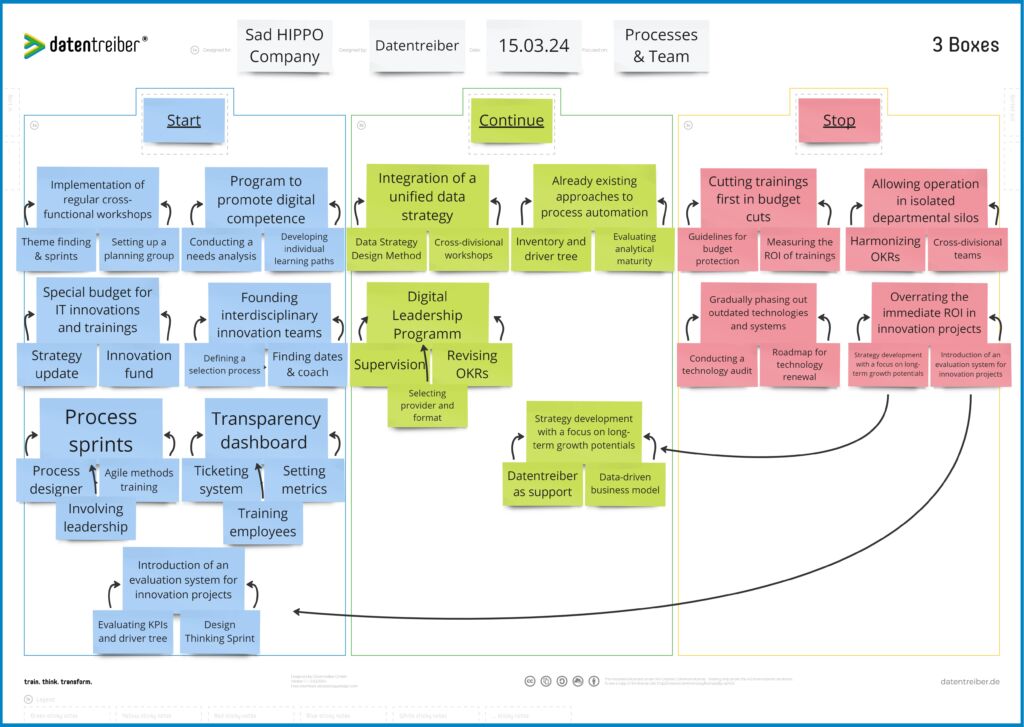In the final part of our article series on the Datentreiber Canvas, we address this challenge using the Data Strategy Design Method.
The right information is the fuel of every decision-making process in companies. This also counts for data-driven decisions. In our previous articles, we first showed how to identify challenges and problems using the 3-Boxes Canvas, covering the “what” question. We then examined these with the Cause and Effect Canvas to understand their underlying causes, examining the “why” question, by finding root causes. The next step is to translate this gathered information into actionable recommendations for a future data strategy. Only when information leads to action does its true value become apparent.
The Question of “How”
On their transformative journey towards data-driven decisions and processes within the company, we revisit the fictional company example, Sad HIPPO Company. This company, which has so far relied on opinions rather than data, must now transition to a data-driven approach. The metaphorical image of ‘HIPPO’ stands for decision-making based on gut feeling and experience (an acronym for “Highest Paid Person’s Opinion”).
We now turn to the ” how “ question: How do we translate the insights gained from the Cause and Effect Canvas into actionable steps? In preparation for the prospective, the participants, guided by the workshop leader, turn their attention once more to the completed Cause and Effect Canvas from the previous sessions.
Translating Causes into Actionable Steps
As identified in our second article, the team has already clustered the causes to recognize patterns and common themes such as budget constraints and cultural hurdles. This process revealed overlaps and dependencies in processes, organization, and leadership.
The Datentreiber Cause and Effect Canvas has assisted in problem analysis and lays the foundation for future solutions and data-driven decisions. Here, we find a detailed mapped-out fault tree with causal chains leading to the core problem, in this case, “problems in ensuring data quality.”
Formulating Actionable Recommendations
The team now focuses on translating these insights into concrete actions. This involves several steps to ensure the recommendations are comprehensive and actionable. By revisiting the results of the previous session, the team carefully now uses the emerged patterns and common themes to pinpoint the exact areas that need intervention so that subsequent actions directly address the root causes of the problems identified.
Based on the clustered causes, the workshop participants brainstorm specific, actionable steps that can mitigate or resolve the identified issues. Each cause is examined to determine the most effective actions that can be taken to address it. The team then uses the 3-Boxes Canvas to structure these actions into three categories: “Start,” “Continue,” and “Stop.” This helps in organizing the recommendations in a way that is easy to understand and implement. The structured approach ensures that all actions are aligned with the overall goal of transitioning to data-driven decisions.
Start: Here, the participants write down actions that should be introduced as new initiatives or practices. Given the recognized patterns, they decide that:
- Implementation of regular cross-functional workshops is necessary to improve communication and mutual understanding between the data and marketing teams, and to break down silo thinking.
- A program to promote digital literacy is developed to bridge the gap in understanding the importance of data quality and the necessary technological skills, as well as to foster an understanding of the importance of data-driven decisions.
- A special budget for IT innovations and training is set up to modernize the technological infrastructure and continuously educate employees.
Continue: In this area, actions that already have a positive influence and should therefore be maintained or even expanded are noted down:
- The use of advanced analytical tools and methods for data evaluation will not only be continued but intensified through additional resources and training for employees.
- The existing approaches to process automation are to be further developed and expanded to more areas to achieve efficiency gains and reduce manual errors.
Stop: In this field, participants identify practices that have proven to be obstructive or do not bring the desired benefit:
- The practice of cutting training first in budget cuts will be discontinued, as it has been recognized that this causes more costs in the long term by solidifying problems with data quality and inefficient use of technology.
- Allowing operations in isolated departmental silos ends to promote a more coherent, company-wide strategy for data management and use.
- Outdated technologies and systems will be gradually phased out, instead of continuing to waste resources on their maintenance, paving the way for modern solutions.

SMART Goals and “How Might We…?” Questions
The team is satisfied and would like to congratulate themselves already. However, the workshop leader insists on digging deeper, asking more specific questions, and not forgetting that overarching insights already exist. Especially in the areas of processes, organization, and leadership, there is significant potential for improvement, as many causes are rooted here.
The team should continue to ask “How” and generate a variety of ideas while paying particular attention to what might be the core drivers of the identified problem areas. This process, often referred to as a “Guesstimation,” involves both an initial estimate and an intuitive evaluation without claiming to have complete or fact-based knowledge. In subsequent steps, the ideas can then be re-evaluated, for example, based on the SMART criteria.
Together, the participants now takes a step further and sharpens the already identified ideas and projects through more specific, goal-oriented questions. The workshop leader encourages the team to apply the “How might we?” question method to generate more concrete ideas from the generic statements on the notes. Also, the SMART method (SMART stands for: specific, measurable, accepted, realistic, time-bound) should help to ensure that the planned measures are not just on paper, but cause realistic and effective changes in the organization.
To illustrate this process, the workshop leader introduces three exemplary “How might we?” questions, directly derived from the previously discussed topic areas:
- “How might we” improve communication between our departments so that knowledge exchange and collaboration become the norm? This question aims to develop concrete measures to promote information flow and collaboration between different teams, for example, by introducing regular interdisciplinary meetings or creating shared digital workspaces.
- “How might we” create an environment where continuous education and development of each individual is encouraged? This is about developing specific strategies on how the company can support a culture of lifelong learning, such as through individual training plans or providing an internal learning portal.
- “How might we” design our technological infrastructure to be flexible enough to meet future requirements? This question encourages the team to think beyond the modernization of IT systems and develop a plan for continuously adapting and updating technologies.
The concept behind these questions, which is often applied in Design Thinking processes, is to transform the problem statement into an open, solution-oriented question that stimulates creative thinking and leads to innovative solutions.
Now, the team of the Sad HIPPO Company can now look back on the progress made with satisfaction and was able to visualize immediately tangible and structured results on the 3 Boxes Canvas.

The workshop leader emphasizes that answering these questions not only found more specific and actionable solutions but also helped to critically question the underlying assumptions and challenges once again. The found answers and ideas should always meet the majority of the SMART criteria (specific, measurable, accepted, realistic, time-bound) to present themselves as justifiable options.
Moving Towards a Future of Data-Driven Decisions with Datentreiber
The methods we have demonstrated are two possible ways to translate the insights gained into recommendations for action. This ensures that ideas move beyond the confines of sticky notes and become actionable in corporate reality. This requires a delicate touch by the workshop leader, a solid set of methods like the Data Strategy Design Method from Datentreiber, and also a collective “yes” from the entire team.
In our example, the Sad HIPPO Company has made a significant step towards a data-driven future through structured engagement with past events and the identification of core problems, all the way to the development of SMART goals.
Not only were existing questions answered, but new challenges were also uncovered. These have far-reaching strategic and operational consequences. For the Sad HIPPO Company team, it’s clear: The transformation requires more than just overcoming current obstacles. It’s about a profound realignment, creating an agile and innovative environment. For this, continuous change management, investments in leadership and employee development, strategic resource allocation, agile processes, a resilience-oriented culture, as well as regular measurements and adjustments are possible important milestones towards a future of data-driven decisions.
The Sad HIPPO Company team learned to connect fragmented elements of a problem area, asking the right questions and setting the right direction through the formulation of concrete goals. Discovering new and open questions is just as important a step as setting recommendations for action.
Train. Think. Transform. – For Your AI Strategy of Data-Driven Decisions
Datentreiber is ready as a partner to support companies on this journey. With our proven Data Strategy Design Method and an expert network for various areas of data, AI, and business questions, we accompany you from developing a holistic data strategy to successful implementation towards data-driven decisions.
Our guiding principle: “Train.Think.Transform.” are more than just buzzwords; they form the foundation of our end-to-end solutions.
Train. – stands for training all employees to create a common understanding of data and the foundation for innovative changes.
Think. – challenges every company to tackle challenges and problems and to develop individual solutions towards data-driven decisions. Supported by our proven Data Strategy Design Method with over 18 interconnected canvases, we work with you to develop clear recommendations for action to enable informed decisions in your organization.
Transform. – means successfully implementing the recommendations for action. We can accompany your teams through coaching during the implementation, as well as rely on an expert network to master individual challenges through their use.
Do you want to make data-driven decisions? Book a free, 15-minute consultation with Georg Arens.
